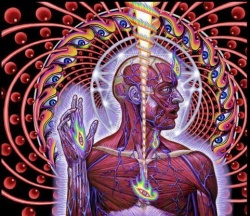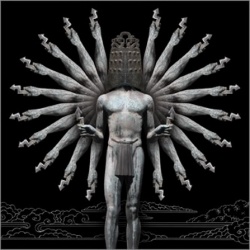Suffering and the Skandhas
The word we sometimes use in English interchangeably with "person" is "individual" that carries the idea of "not divisible." But the Sanskrit term pudgala that is used by Jains and by Buddhists which confers that same "person" meaning actually connotes a temporary entity that is prone to separation into parts and then, to assimilation. It is not one whole that is a solid, indivisible entity. Instead the person is viewed as made up of five different aspects called the 5 Skandhas or Five Aggregates. These are not physical components, but rather an agglomeration or coming together of subliminal inclinations or tendencies.
Suffering and the Skandhas
"Everything is suffering [Skt. dukkha, pron. dook-ha]" is the 1st 'Noble' Truth (aryasatya) Noble> arya which here means supreme, ultimate.)
Suffering = un-satisfactoriness, not OK, and much of that has to do with the impermanent nature of phenomena [things, events and states] due in part to the fact they are composed of temporary assemblages or skandhas.
Impermanence
Existence is suffering primarily because, by its very nature, it is impermanent. That is, people, animals, things, circumstances ("life-style") and all the components that go to make them up - good health - are transitory. Often the word chosen to translate dukkha is 'unsatisfactoriness'.
Though they say in French, "Plus ça change, plus ç'est la mème chose" [The more things change, the more they remain the same] that sameness is never permanent but always changing, uncertain, often risky and creating of stress).
The doctrine of why and how this is appears in the MahaNidana Sutta or The Great Causation Sutra.
The Buddhist view is that every individual is an entity composed of five categories of phenomena or qualities that may be thought of as aggregates, skandhas in Sanskrit; sometimes translated as heaps or accumulations.
The Five Skandhas, also called Formations are:
form (rupa)
apperception or sensibility
perception
volition, will
consciousness
1. Form is composed of matter made up of four elements: earth, water, fire, wind.
2. Apperception or sensibility is derived from the sense organs:
eye enables sight
ear enables sound
nose enables odour
tongue enables taste
"body" enables touch
mind enables the experiences of the five organs above, but also of its own objects called, like the word for the Teachings, dharma s ('facts').
This set of pairs, ie. organ + function, is known as the Twelve (12) Bases of Consciousness.
3. Perception is a product of the six externals above: sight, sound, etc. It is the individual's processing of the 12 bases to 'feel' the environment. [This skandha is sometimes referred to as 'feeling' though that word could be used in an vague way for any of the skandhas from 2 through 4.]
4. Volition (samskara) is the reaction of the will to the objects and may produce aversion, attraction, etc. In other words, the feeling as basis for emotion.
5. Consciousness vijnana) grasps the qualities of the six objects. It creates a third member of the sets in 2 above. These are designated Visual consciousness, Auditory consciousness, and so on, ending with Mental consciousness. The eighteen now, are called the Eighteen (18) Elements dhatu).
These five aggregates or formations, the skandas, are not ultimate and eternal in nature but are conditioned. They arise from causes and circumstances. Like all phenomena, they come and go; endure and change and disappear.
Since we are composed of these, we are impermanent. There is no part of us that is eternal. We cannot logically say, "That is mine; I am that; that is my Self"
A root text (Pali version in translation) is "Assumptions" or Samanupassana Sutta (Samyutta Nikaya XXII.47)
____________________________________________________________________________________
BBW describes the skandhas using slightly different terminology:
1. Form -- the physical aspect
2. Perception -- the first non-physical layer, the bare, non-complex image, sound, etc.
3. Feeling -- how [what?] we feel, i.e., good, bad, ugly, indifference, etc.
4. Formation -- conceptual composite formation of what gets filtered through feeling and perception, when coming in; or, when going out. Also described as the thoughts or intentions of carrying out [or implementing] an action.
5. Consciousness -- thoughts and deeper levels of the mind.
Feeling is simply good, bad, and neutral -- from one's own self-centered angle, of course. It is like a filter that alters one's perception of the external world of "form."
In Gateway to Knowledge (Hong Kong: Rangjung Yeshe, 1997) Jamgon Mipham Rinpoche used the word, sensation, which is another way to translate the Sanskrit word for feeling, as follows:
"Sensations are defined as impressions. The aggregate of sensations can be divided into three: pleasant, painful, and neutral. Alternately, there are five: pleasure and mental pleasure, pain and mental pain, and neutral sensation."
So the 2nd skandha could be called apperception, sensation or feeling.
And the 3rd could also be called feeling but in the sense of a qualitative or basis-for-emotion reaction.
The Buddhist analysis is impressive when we consider that it is only with the rise of physiological psychology in the late 19th century that we in the West generally began to examine the nature of our reactions to stimuli and the way we interpret experience.
From the Buddhist perspective, though we may and do speak of rebirth, there is no eternal essence, soul or Self that is considered to incarnate.
Called form, feeling, perception, formation and consciousness, they are labeled the Five Aggregates because in turn they too are not solid indivisible whole entities and are made up of even smaller parts. The break-down [can go] on and on, until there is not even a single particle which one can call a Self. They only come together as an "aggregate" due to causes and conditions. Since it does not have an unchanging self and is impermanent (i.e., when the causes and conditions are gone, so is it;) it is EMPTY. ~ BB


